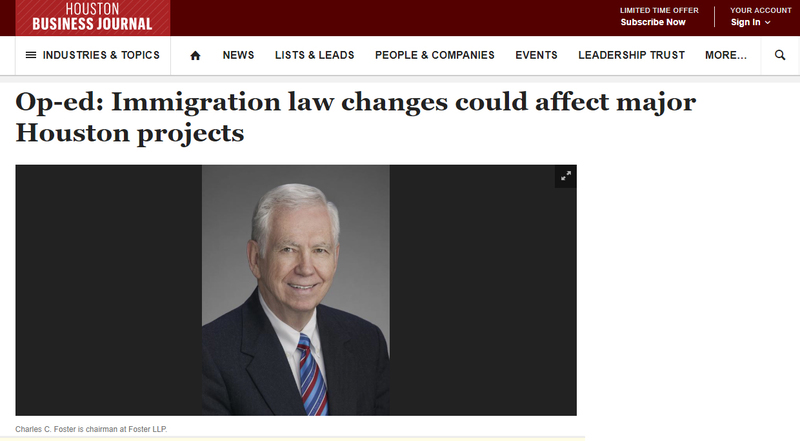Immigration law changes could affect major Houston projects
The EB-5 investor program, which has provided significant funding to major Houston real estate developers and a viable way to legally immigrate, is about to undergo a major regulatory change. Immigrating to the U.S. is highly restricted, but one of the few viable ways to immigrate without family or employment-sponsorship has been through the EB.
EB-5 funds have played an important part in various Houston projects, including Roberto Contreras’ Houston EB-5 Astoria, Arabella and Marlowe real estate luxury condominium projects, as well as funding for The Allen, a large real estate mixed-use project located on Allen Parkway next to the Federal Reserve building. EB-5 investments have also funded, in part, Texas Regional Fortune Center’s Houston Urban Lenders Project, which raised significant funds for single- family units, retail, office and multi-family residential projects, as well as the funds for the re-development of the former downtown U.S. post office.
Linbeck Groups’ Texas Regional Center has developed One Market Square, a 41-story mixed-use office building and garage in downtown Houston. Civitas has developed a downtown multifamily residential complex at 1414 Texas, CanAm Regional Center has developed the Westin Hotel adjacent to the Texas Medical Center, CMB Regional Center re-developed the historic Texaco Building in downtown Houston as a condominium, and many other projects have been developed, all using the EB-5 Program, which has provided in recent years more than $600 million for real estate development in Houston.
Final Regulations published by U.S. Citizenship & Immigration Services (CIS), effective November 21, 2019, substantially amends the EB-5 investor program through which foreign nationals who do not have a close U.S. citizen or lawful permanent resident family member, or employment sponsorship still have a direct way to immigrate and obtain their U.S. lawful permanent residency or “green card.”
The Immigration Act of 1990, signed by President George H.W. Bush, provided that one could immigrate based upon a $1 million investment in a new enterprise creating 10 full-time jobs for U.S. workers. However, if the enterprise was located in a Targeted Economic Area (TEA) — a rural or high unemployment area — the minimum investment amount has been $500,000. As a practical matter, as this program evolved after the 2008 recession, it became a de-facto five-year $500,000 loan program paying only a low interest rate for major real estate projects through an approved CIS Regional Center. For many, this has been the only way to qualify for U.S. lawful permanent residency, which would otherwise be impossible without a lawful qualifying U.S. family member or sponsorship by a U.S. employer.
But, under CIS Final Regulations that go into effect Nov. 21, the minimum investment amount is increased from $1 million to $1.8 million and for investment in approved TEA projects from $500,000 to $900,000. However, for most regional center projects, the minimum investment amount will effectively increase from $500,000 to $1.8 million because most regional center projects, which now qualify for the lower investment amount by being located in a TEA, will no longer be able to do so.
It is clear that a growing number of EB-5 investor petitions will be filed on Form I-526 before the Final Regulations go into effect to take advantage of the $500,000 minimum investment requirement. This will likely result not only in increased backlog under the EB-5 annual 10,000 quota, but also a significant processing backlog.
As you often hear, in radio and T.V. commercials, this truly is a “once-in-a-lifetime opportunity.” Thus, for those foreign nationals who ever have thought about acquiring U.S. Lawful Permanent Residency, and will never be able to do so through a family or employment option, as lawyers like to say: “time is of the essence,” and the sooner a decision is made, the better.
For developers, there will be far fewer, available, and qualified investors at $1.8 million, but the good news is, at that dollar amount, fewer investors will be needed. Furthermore, for foreign nationals seeking residence in other countries offering economic and political stability, the U.S. EB-5 program, even at the higher dollar amount, is still relatively competitive in comparison.
Mentions
- Charles C. Foster
- U.S. Citizenship and Immigration Services
- Arabella Houston
- Marlowe
- CanAm Enterprises, LLC
- Texan Regional Center
States
- Texas
Securities Disclaimer
This website is for informational purposes only and does not constitute an offer or solicitation to sell shares or securities. Any such offer or solicitation will be made only by means of an investment's confidential Offering Memorandum and in accordance with the terms of all applicable securities and other laws. This website does not constitute or form part of, and should not be construed as, any offer for sale or subscription of, or any invitation to offer to buy or subscribe for, any securities, nor should it or any part of it form the basis of, or be relied on in any connection with, any contract or commitment whatsoever. EB5Projects.com LLC and its affiliates expressly disclaim any and all responsibility for any direct or consequential loss or damage of any kind whatsoever arising directly or indirectly from: (i) reliance on any information contained in the website, (ii) any error, omission or inaccuracy in any such information or (iii) any action resulting therefrom.




